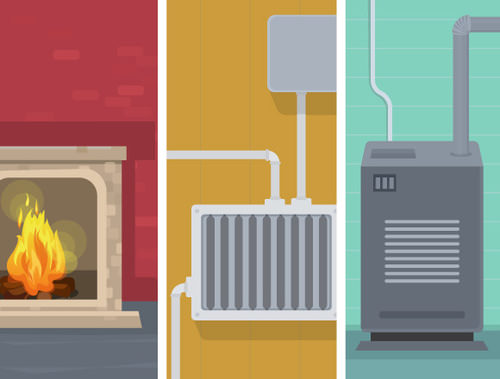17.10 热化学赤道
章节大纲
-
What is the best way to heat a house?
::取暖房子的最佳方式是什么?Heating a home is becoming more and more expensive. Do we use , oil, electricity, wood? Part of the decision is based on which fuel will provide the highest amount of energy release when burned. Studies of thermochemistry can be very useful in getting reliable information for making these important choices.
::取暖家庭正在变得越来越昂贵。 我们是否使用石油、电力、木材? 部分决定的基础是燃料在燃烧时能提供最大的能量释放量。 热化学研究对于获取可靠信息以做出这些重要选择非常有用。Thermochemical Equation
::热化学等量When methane gas is combusted, is released, making the reaction exothermic . Specifically, the combustion of 1 mol of methane releases 890.4 kilojoules of heat energy. This information can be shown as part of the balanced equation .
::当甲烷气体被燃烧时,释放出来,使反应变得异常热。 具体地说,1兆瓦甲烷燃烧释放了890.4千焦耳的热能。 这些信息可以作为平衡方程式的一部分显示。CH 4 ( g ) + 2 O 2 ( g ) → CO 2 ( g ) + 2 H 2 O ( l ) + 890.4 kJ
::CH4(g)+2O2(g)+2O2(g)+CO2(g)+2H2O(l)+890.4千焦耳The equation tells us that 1 mol of methane combines with 2 mol of oxygen to produce 1 mol of carbon dioxide and 2 mol of water. In the process, 890.4 kJ is released and so it is written as a product of the reaction. A thermochemical equation is a chemical equation that includes the change of the reaction. The process in the above thermochemical equation can be shown visually in Figure .
::该方程式告诉我们, 1 mol 甲烷与 2 mol 氧气结合, 产生 1 mol 二氧化碳 和 2 mol 水。 在这一过程中, 890.4 kJ 被释放, 因此它被写成反应的产物。 热化学方程式是一个化学方程式, 包括反应的变化。 上述热化学方程式的过程可以在图中显示为直观 。(A) As reactants are converted to products in an exothermic reaction, enthalpy is released into the surroundings. The enthalpy change of the reaction is negative. (B) As reactants are converted to products in an endothermic reaction, enthalpy is absorbed from the surroundings. The enthalpy change of the reaction is positive.
:A) 当反应器在异温反应中转化为产品时,被释放到周围环境,反应的变是负的。 (B) 当反应器在异温反应中转换成产品时,被周围吸收。反应的变是正的。
In the combustion of methane example, the enthalpy change is negative because heat is being released by the system . Therefore, the overall enthalpy of the system decreases. The is the enthalpy change for a . In the case above, the heat of reaction is −890.4 kJ. The thermochemical reaction can also be written in this way:
::在甲烷的燃烧中,由于系统释放出热量,蚂蚁的变异是负的。因此,整个系统变异的蚂蚁会下降。这就是一个变异的蚂蚁。在以上的例子中,反应的热量是-890.4千焦耳。热化学反应也可以这样写:CH 4 ( g ) + 2 O 2 ( g ) → CO 2 ( g ) + 2 H 2 O ( l ) Δ H = − 890.4 kJ
::CH4(g)+2O2(g)+CO2(g)+2H2O(l)+890.4千焦耳Heats of reaction are typically measured in kilojoules. It is important to include the physical states of the reactants and products in a thermochemical equation as the value of the Δ H depends on those states.
::反应热通常用千焦耳测量,必须将反应器和产品的实际状态纳入热化学方程式,因为H值取决于这些状态。Endothermic reactions absorb energy from the surroundings as the reaction occurs. When 1 mol of calcium carbonate decomposes into 1 mol of calcium oxide and 1 mol of carbon dioxide, 177.8 kJ of heat is absorbed. The process is shown visually in Figure (B). The thermochemical reaction is shown below.
::当1毫升碳酸钙分解成1毫升氧化钙和1毫升二氧化碳时,吸收了177.8千焦耳的热量。图(B)显示了这一过程。下文显示了热化学反应。CaCO 3 ( s ) + 177.8 kJ → CaO ( s ) + CO 2 ( g )
::CaCO3+177.8 kJCaO+CO2(g)Because the heat is absorbed by the system, the 177.8 kJ is written as a reactant. The heat of reaction is positive for an .
::由于热量被系统吸收,177.8千焦耳被写成反应器。CaCO 3 ( s ) → CaO ( s ) + CO 2 ( g ) Δ H = 177.8 kJ
::CaCO3+CO2(g)+CaO(s)+CO2(g)+H=177.8千焦耳The way in which a reaction is written influences the value of the enthalpy change for the reaction. Many reactions are reversible, meaning that the product(s) of the reaction are capable of combining and reforming the reactant(s). If a reaction is written in the reverse direction, the sign of the Δ H changes. For example, we can write an equation for the reaction of calcium oxide with carbon dioxide to form calcium carbonate.
::书面反应的方式影响过量变化对于反应的价值。 许多反应是可逆的, 这意味着反应的产物能够合并和改造反应器。 如果反应是反向写的, 则QH的标志会改变。 例如, 我们可以写一个公式, 用于氧化钙和二氧化碳的反应, 形成碳酸钙。CaO ( s ) + CO 2 ( g ) → CaCO 3 ( s ) + 177.8 kJ
::CAO+CO2(g)CaCO3+177.8千焦耳The reaction is exothermic and thus the sign of the enthalpy change is negative.
::反应是过热的,因此,变化的迹象是负的。CaO ( s ) + CO 2 ( g ) → CaCO 3 ( s ) Δ H = − 177.8 kJ
::CAO+CO2(g)+CaCO3+H177.8千焦耳Summary
::摘要-
The components of a thermochemical equation are described.
::叙述热化学方程式的成分。
Review
::回顾-
What does a thermochemical equation include?
::热化学方程式包括什么? -
Why would this information be important?
::为什么这一信息很重要? -
What happens to the sign of the enthalpy change when the reaction is reversed?
::当反应逆转时 的改变迹象会怎样呢?
-
The components of a thermochemical equation are described.

